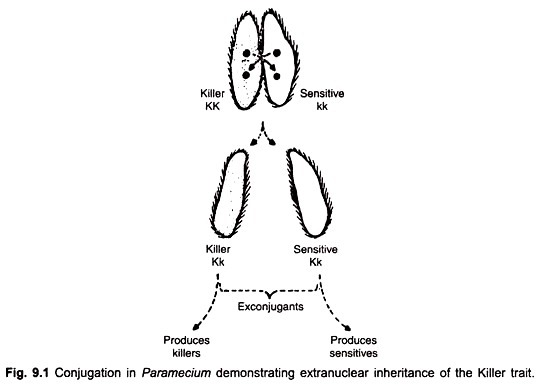Sonneborn in 1938 discovered certain strains in Paramecium which showed a killer trait due to the presence of a cytoplasmic factor called kappa. The killer strain can destroy the sensitive strains growing in culture which do not have kappa by liberating a toxic substance paramecin. Killer strains are not killed by their own paramecin.
Paramecium has two kinds of nuclei, a small micronucleus and a very large macronucleus which is highly polyploid and irregular in shape and behaviour during cell division. Only the micronucleus behaves according to Mendelian principles. Paramecium has three modes of reproduction. The first is a simple mitotic division called binary fission. The second method is conjugation.
Here two protozoans divide meiotically to form four micronuclei in each cell; out of these, three nuclei degenerate and only one remains which divides by mitosis to produce two genetically identical haploid nuclei in each Paramecium. During conjugation only one of the two haploid nuclei is exchanged through a cytoplasmic bridge formed between the two ciliates. The cells then separate as two ex-conjugants.
The third method of reproduction is called autogamy. Here a single Paramecium divides meiotically and by the same process that occurs in conjugation, two identical haploid nuclei are formed which fuse to form a diploid organism. As there was no genetic exchange, the diploid Paramecium is homozygous.
One noteworthy feature of the sensitive strains is that they are not killed by paramecin while they are in the process of conjugation. This has an advantage because it allows the investigator to perform crosses between the killer and sensitive strains.
The two strains can be distinguished morphologically as killers have granular cytoplasm and sensitives are clear. When a cross is made between a killer and a sensitive Paramecium (each made homozygous by autogamy), there is exchange of genetic material through conjugation.
This is followed by separation of the two genetically identical ex-conjugants. It is found that killer ex-conjugants produce only killer Paramecia and the sensitive ex-conjugants only the sensitive Paramecia. Obviously, the killer and sensitive traits are not controlled by Mendelian genes (Fig. 9.1).
If the heterozygous (KK) killer ex-conjugant is inbred to another heterozygous killer, it produces three-quarter killer (1 KK and 2 kk) and one quarter sensitives (kk). But if the sensitive ex-conjugant (Kk) is crossed to another heterozygous sensitive, it results in all sensitive progeny even though their genotypes are in the ratio of 1 KK: 2Kk: 1kk. The results suggest non-chromosomal inheritance of killer trait.
The final proof regarding inheritance of killer trait was obtained by modifying the experiment in the following way. The cross between killer and sensitive was prolonged, allowing enough time for exchange of cytoplasm to take place.
In this way, some of the kappa particles could move from killer into the sensitive strain. All the resulting progeny of such a cross consisted of killers thus confirming the cytoplasmic inheritance of kappa particles.
The above experiment can be performed in such a way that Paramecia divide very rapidly by controlling the nutrient conditions. Under such conditions, a homozygous killer strain (KK) containing kappa particles can produce a few individuals that are sensitive and without kappa particles.
The explanation is that kappa particles cannot multiply as rapidly as the cells, and become fewer in number in comparison with the number of Paramecium cells. Due to their reduced number kappa particles are not passed on to some members of the progeny at all.
It was found that although kappa particles are transmitted cytoplasmically, yet they require a dominant K gene for maintenance. The K gene cannot initiate the presence of kappa particles. Kappa are virus-like particles about 0.2 micron in diameter and have ability to reproduce independent of the nucleus. They have their own DNA, can multiply and produce the substance paramecin.
